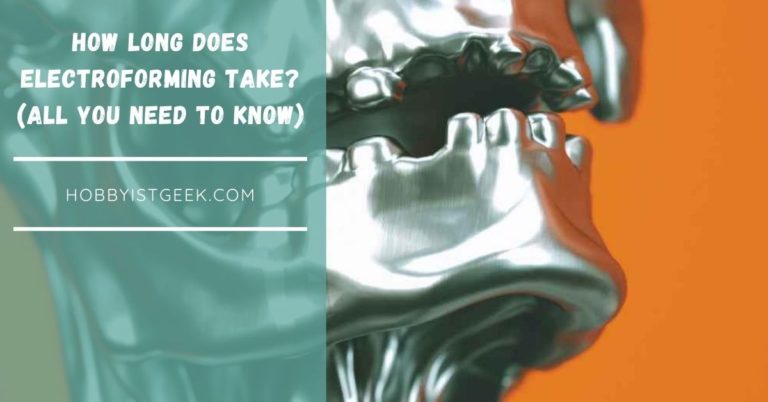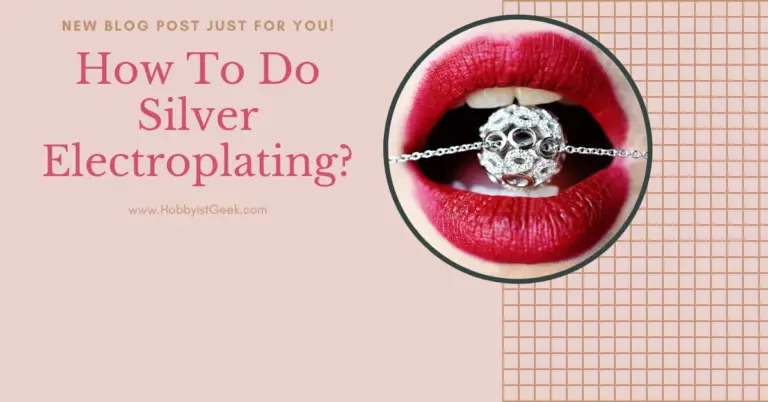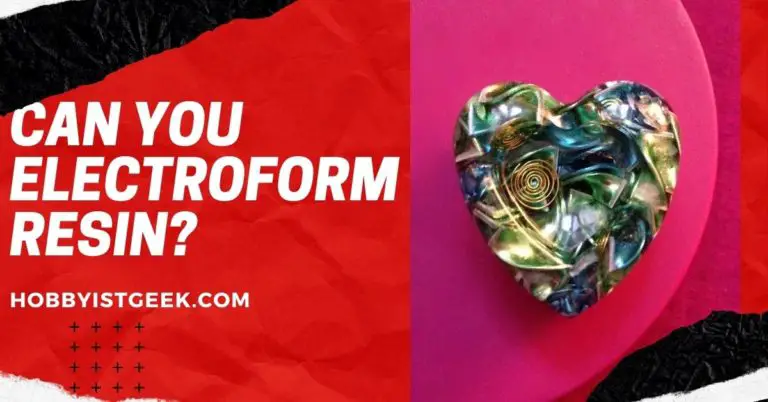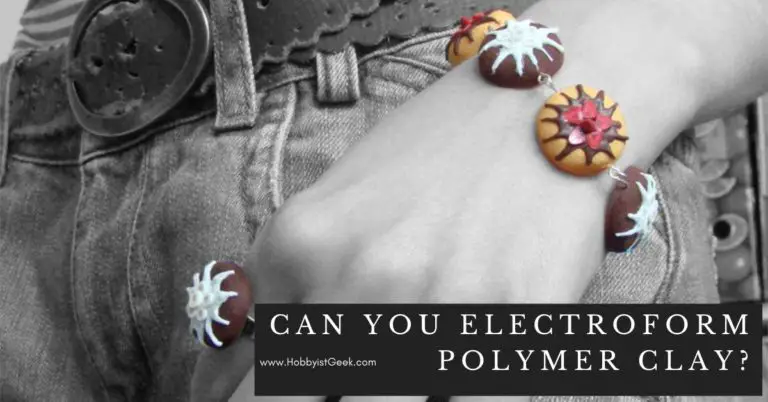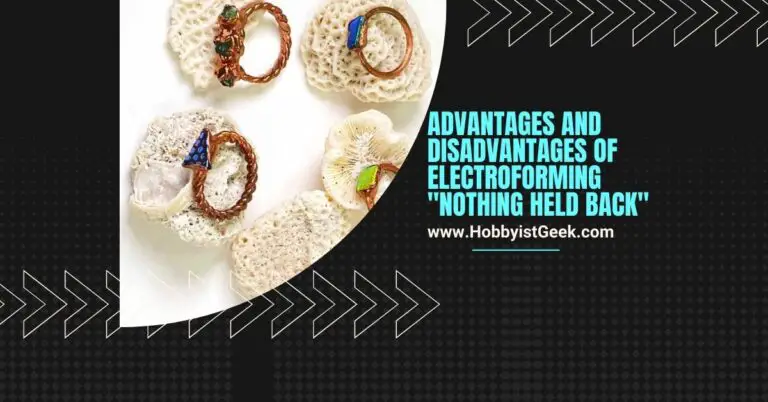Troubleshoot Electroforming Top 9 Problems With Fixes?
If You Want To Learn Electroforming This Is For You…
In this article, we will cover how to Troubleshoot Electroforming Top 9 Problems With Fixes?
Are you just starting as an electroforming artist?
Then you’ll have experienced just how difficult the art of electroforming can be, and any art for that matter.
Many things can go wrong, and when you’re just starting on the long and exciting journey of learning a new discipline they will most likely go wrong at least once, but there’s no shame in that, we all have to start somewhere and there’s no climbing without falling.
One of the most difficult aspects of advancing in an art like electroforming is figuring out where the whole process went south, and that’s exactly the reason for this article you landed on!
We’ll help you figure out the breaking points of your project and provide elegant and appropriate solutions so that your electroforming journey will be back in action in no time!

The Answer To The Question… How To Troubleshoot Electroforming Top 9 Problems And How To Fix Them?
Troubleshooting electroforming copper can help improve your results and can make you a better artist by making you identify your mistakes and help you learn from them!
Do your pieces come out dull, rough, or patchy? Poor electrical connections might be the culprit, this occurs when your electrical circuit is malfunctioning or completely broken and can have varying consequences!
If your pieces look a little pink and dull it might be due to Low Brightener Levels. Brightener quite literally “Brightens” your piece, so a lack of brightener can cause dull, rough, and unsatisfactory results!
An often-overlooked issue is poor use or using the wrong copper conductive paint causing pink and dull-looking results.
During this article, we’ll discuss those issues and plenty more in stunning detail!
Contaminated Electroforming Solution:
With that out of the way let’s jump straight into the first common problem that we’ll be looking at, contamination of the electroforming solution.
Do you have large bumps on your final result, or perhaps no copper plating at all?
Both symptoms can be blamed on a contaminated bath of electroforming solution!
Contaminated baths occur when chemicals or substances that are not part of the regular chemical make-up of an electroforming solution contact the fluid.
This happens more often than you might think and it’s even a problem among experienced electroforming artists as something as simple as a dirty environment might contaminate the bath.
Generally, this issue arises when the piece you’re trying to electroform isn’t sealed properly or when a poor filtration system fails to maintain the chemical balance in the bath.
Luckily, bath contamination can easily be prevented through proper sealing and a decent filtration system.
Sealing the piece you’re trying to plate is an essential part of the electroforming process and it consists of coating the organic piece in a non-conductive, waterproof layer of a substance like Resin, Nail Polish, or any specific sealant brand. Sealing prevents contamination by making the object waterproof so that no organic material is directly exposed to the acidic environment of the bath.
If for whatever reason, your solution does end up being contaminated the best, and only, thing you can do is make a new solution and properly clean out the bath and give it another shot!
Bath contamination is a very common issue and it happens to the best of us.
When you get more experienced you’ll learn not to contaminate your electroforming solution.
Poor Electrical Connections:
Jumping from one issue to another let’s look at our next issue, this next issue has varying levels of severity and effect.
Does your piece look a little dull, or does it feel rough and patchy? In the worst-case scenario, there’s no electroforming taking place at all.
If any of these observations sound familiar to you, you might want to check your electrical connections!
These symptoms can be caused by a faulty electrical circuit or perhaps even a completely broken one.
A faulty electrical circuit causes unstable fluctuations in amperage and current causing rough patches on your piece.
If your circuit is completely broken no electricity passes through your electroforming setup and thus, obviously, no electroforming can take place!
A poor electrical connection can have a lot of causes such as broken wires or rusted clips, but luckily for us, the most common occurrence is something that can easily be fixed such as a clip that slipped off or a clip that doesn’t make full contact.
The best practice, in this case, would be to do a complete rundown of the entire electrical circuit, making sure you check everything, especially things like your anode, cathode, and wires.
Check if they’re connected properly and see if they all make optimal contact with one another, if so, run your electroforming setup again and see if your issues are resolved! If they persist you might want to skip ahead in this article and have a look at the section on “Conductive Copper Paint” as this has similar symptoms!
If that doesn’t resolve the issues either, it’s probably best to order reserve components for your entire electrical system or replace parts one by one to discover the culprit of your issues!
Electrical issues can easily be prevented by taking good care of your equipment and replacing components before an issue presents itself!

Help! Copper didn’t fully plate!
Copper Conductive Paint
Now we move onto another conductivity issue, very closely related to a poor electrical connection.
The symptoms are highly similar, from rough patches to a complete stop of the electroforming process.
I’m talking about poorly chosen copper conductive paint! Copper conductive paint is used to apply a conductive coating to the piece you’re trying to electroform, and it acts as a map for where the new copper layer will form!
Issues with conductive paint can arise when the wrong paint type is chosen or when the paint is poorly applied.
There are many different types of copper conductive paint and it is essential to choose the right one for your project.
Make sure you’ve got conductive paint for the metal you’re using, in this case, copper, and check if the paint you’ve chosen is suitable for the material you’re working on.
If you’re working with a plastic piece, for example, make sure you find the appropriate paint!
There are many types of conductive paint that I use, for instance
If you’re sure about the paint you’re using, have a look at the packaging and see if the paint is still within its shelf life date limit, as outdated copper conductive paint has serious consequences for the conductivity and functionality of the paint.
If you’ve made sure you chose the correct paint for the job but the issues still persist, make sure you’re working in a clean, well-ventilated room as diluting the paint can have a serious impact on its conductive properties and thus on its functionality!
Use The Correct Conductive Paint To Get The Desired Texture On Your Piece.
There are many types of conductive paint that I use, for instance, I mix equal parts of mod podge and graphite powder, if I want a consistency that he’s a bit looser I add equal parts of India ink and graphite powder.
If I want more texture on my piece I take the mod podge and graphite powder and add Little pieces of glass scrap and small pieces of wire these are the things that add texture to the peace.
They are also different ways to apply the conduct of paint. The three that I use the most are brushing, dipping, and spraying the conduct of paint on my piece.
When applying the copper conductive paint always take the necessary precautions and do your research, if you do this well you should be able to avoid these issues in the future!
Low Brightener Levels
Onto our next common problem.
Do your pieces come out dull, rough, or even a little pink?
Are they just not quite as bright and shiny as you perhaps want them to be?
Don’t worry!
These issues arise when you don’t add enough brightener to your setup during the electroforming process.
Brightener, as the name suggests, makes the copper brighter and shinier by becoming part of the new copper surface.
This means that brightener depletes during the electroforming process and thus on larger scale projects.
It won’t be sufficient to only add brightener at the start!
The solution to this problem is rather obvious, just add more brightener!
It is best to apply a certain amount of brightener at certain intervals during the electroforming process.
You should add brightener before you start to electroform This way the brightener will be evenly distributed across the newly formed surface and you will be greeted by a nice and shiny surface!
It’s better to be safe than sorry on this aspect of electroforming, as there is no such thing as adding too much brightener, if you stay reasonable and don’t unnecessarily add liters of it, of course!
So, the next time you’re in doubt about the quantity of brightener to use during your project, just add a couple of drops to be safe!
If none of these techniques solve your problem, you can try a technique known as Charcoal Filtering.
This method consists of using activated charcoal to filter out dirty chemicals and other things that don’t belong in your electroforming bath.
If nothing helps and all seems lost, skip ahead in this article to the section on “High/Low Bath Temperature” as they cause similar symptoms!
High Temperature of Electroforming Bath
For this next issue we’re facing similar issues as we did in the Brightener section, our final result looks dull, rough, and perhaps a little pink.
Once you’ve verified that your brightener levels are where they should be, and the issue persists, the symptoms might have a different culprit.
Similar symptoms are caused by a too high bath temperature, the optimal temperature of your electroforming bath lies between 18℃ and 30℃, or between 64℉ and 86℉.
You can easily measure the temperature of your bath using a simple thermometer to get an accurate reading of your bath temperature.
If it’s anywhere outside of this range it can cause issues.
Luckily, this problem is easily resolved by bringing the electrolyte temperature back into that optimum temperature range.
If you want to test your bath temperature and brightener levels, you can do something known as the 10p coin test.
Simply put, the 10p test works as follows; take a 10p coin and prepare it for the electroforming process (cleaning, sanding, etc.), then place it in your electroforming setup and let it electroform for around 10 minutes.
Once you take out the coin it should be back shining brighter than ever, if it doesn’t you should change the bath temperature or the brightener levels!
It’s always good practice to regularly check your bath temperature during the electroforming process to avoid said issues!
Low Bath Temperature
Our next issue has very similar symptoms, causes, and fixes as our previous one as it’s very closely related.
If your bath temperature is below the 18℃ (64℉) limit, once again this can be easily measured using a regular thermometer, similar issues occur as when it’s above the 30℃ (86℉) limit.
I won’t spend too much time on this issue as it is fixed in a similar way as the previous one by checking the temperature of the bath regularly and using the 10p coin test to verify your results!
High Current / Amperage
Our next issue is one that commonly presents itself, as the calculations involved can cause some difficulty!
The symptoms of this issue can range anywhere from a little dullness, to a pink color, to even a completely burned piece!
These severe outcomes can be caused by a too high amperage setting.
In electroforming the current should be set according to the surface area of the piece that is being plated, this doesn’t have to be exact and you should be able to approach it using primitive geometric shapes such as cubes or spheres!
The general rule of thumb is setting your amps at 0.1 amps per square inch of surface area, if you are not interested in doing the mathematics yourself you can use this tool, an area calculator, to calculate the surface area of any primitive shape you desire!
It’s highly recommended to start with a lower current setting than you might need as a low current won’t cause any issues, it’ll just slow down the electroforming process while overdoing it with a higher current setting than necessary can seriously damage your project.
If you’ve burned your piece, then sadly there’s nothing much you can do, other than keeping your head up and start again of course!
If your piece isn’t severely damaged it can still be salvaged through any of the techniques in this article!
See the sections on Brightener for more information!
Keep Organics From Floating
For this next issue, we’re facing a very common issue when we electroform organics. There a few fixes for this.
Take your hanging wire and add a piece of scrap or sea glass to the bottom of the organic hanging wire, which should prevent the piece from floating.
Another way to prevent your organic from floating would be to use a heavier gauge wire to add stability to the piece.
The last fix I have used with good results is to create the hook on your hanging wire where your organic will hang then have your hanging wire loosely wrap around the organic this will create a more stable piece. I also use a clip to keep the organic stationery.
Carbon filtering Electroforming tank with pump build
Excess Copper Sludge
The final issue we’ll be looking at today is one that can easily be solved by giving your bath a good cleaning!
Does your piece contain rough patches or nodulation?
This might be due to an excessive build-up of copper in your tank or on your anode.
Excess copper sludge can have many causes ranging from the chemical make-up of the bath to impure anodes.
Luckily for us, the cause of the issue isn’t the main concern here as it can usually be solved by giving your bath a proper cleaning and filtration session.
Filter out all the excess copper sludge and try again!
This issue can be prevented, just like many others on this list, by taking proper care of your equipment by rinsing it off regularly and filtration sessions.
There are multiple types of filtration that you can use, all with their own pros and cons.
Some of the popular ones are using activated carbon to filter out dirty chemicals or pouring your solution through a regular coffee filter to filter out the larger pieces of copper sludge or dirt.
So, to conclude this article we can say that everyone must make their fair share of mistakes before they master any technique.
The art of electroforming is a complicated process and issues are bound to cross your path.
We’ve also learned that taking proper care of your equipment can get you a long way!
I hope this article has helped you with any issues you might have had on your electroforming journey!
Final Thoughts For Troubleshoot Electroforming Top 9 Problems With Fixes?
So, to conclude this article we can say that everyone must make their fair share of mistakes before they master any technique.
The art of electroforming is a complicated process and issues are bound to cross your path.
We’ve also learned that taking proper care of your equipment can get you a long way!
I hope this article Troubleshoot Electroforming Top 9 Problems With Fixes? has helped you with any issues you might have had on your electroforming journey!
Electroforming: The Ultimate Guide Check It Out!
If you’re interested in electroforming, you must check out “Electroforming: The Ultimate Guide” on our blog. This comprehensive guide covers everything you need to know about the electroforming process, from the basics to more advanced techniques. It’s the perfect resource for anyone looking to learn more about the electroforming process. So, what are you waiting for? Click on the link and start reading “Electroforming: The Ultimate Guide” now!
Sources
*, Name. “7 Questions Answered About The Electroforming Bath.” Electroforming Artist, Electroforming Artist, 4 Dec. 2020, electroformingartist.com/electroforming-bath/.
Alchemists, Artists and. “Artists and Alchemists.” The Art of Copper Electroforming, Artists and Alchemists, www.copper.org/consumers/arts/2007/november/Artists_Alchemists_Art_Copper_Electroforming.html.
Community, Ganoskin. “Electroforming Workshop Preparation – Ganoksin Jewelry Making Community.” Ganoksin, Ganoskin, 6 Dec. 2016, www.ganoksin.com/article/electroforming-workshop-preparation/.
Leaves, Enchanted. “Electroforming Tutorial – Free Step by Step Guide to Making Copper Ele.” Enchanted Leaves, Enchanted Leaves, enchantedleaves.com/pages/electroforming-tutorial-free-step-by-step-guide-to-making-copper-electroformed-jewelry-learn-how-to-electroform.
Plating, Gateros. Gateros Plating Ltd, Gateros Plating Ltd, www.gaterosplating.co.uk/electroforming-kit-problems.

Michael
ELECTROFORMING | FUSED GLASS | METAL ARTIST
I’m documenting my electroforming journey step by step. I wish I had this information when I started my electroforming journey.
Pinterest
Facebook
Let Us Know What You Think
- Electroforming Conductive Paint, Where To Buy It, And How To Make It – The Ultimate Guide - April 24, 2021
- Copper Electroforming Solution Recipe - April 20, 2021
- Can You Electroform Polymer Clay? - April 13, 2021


